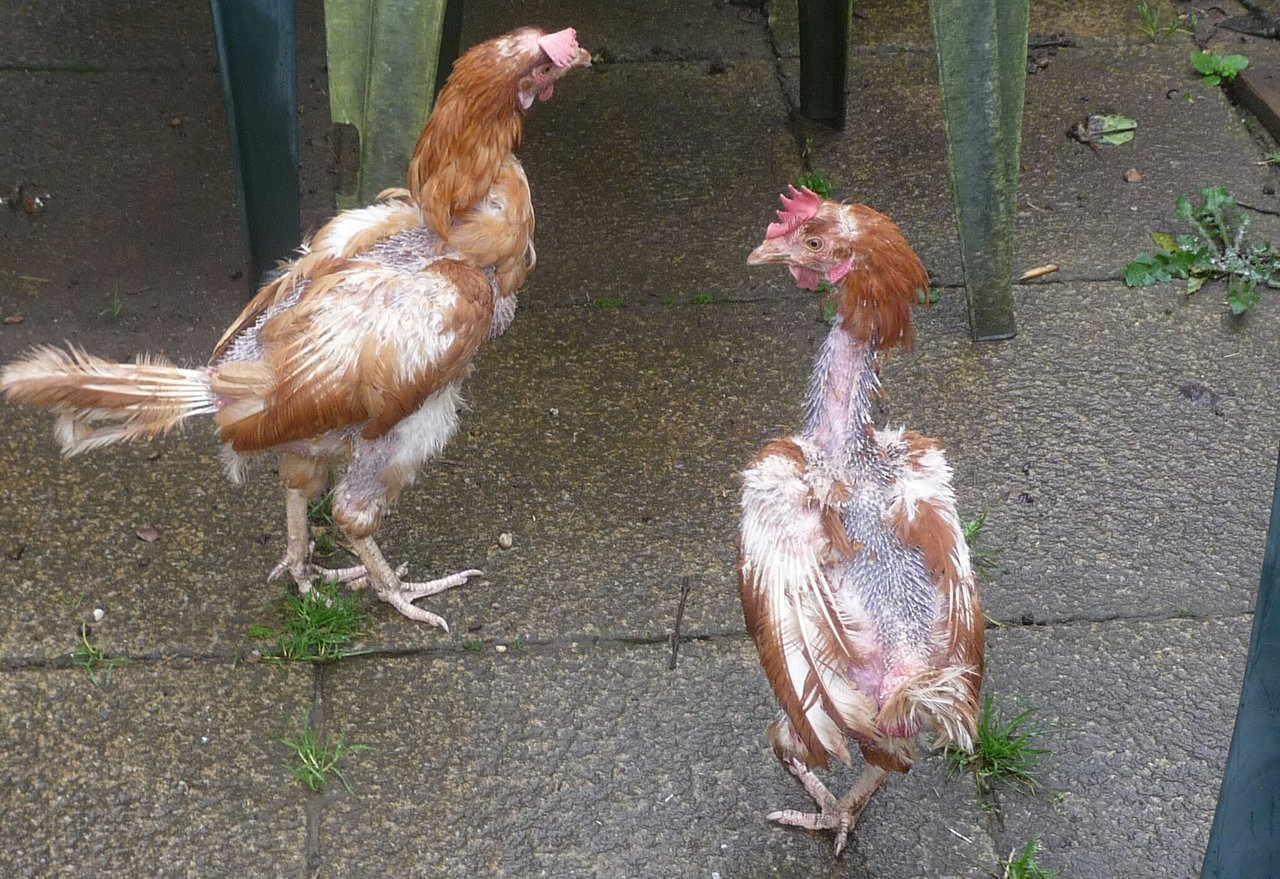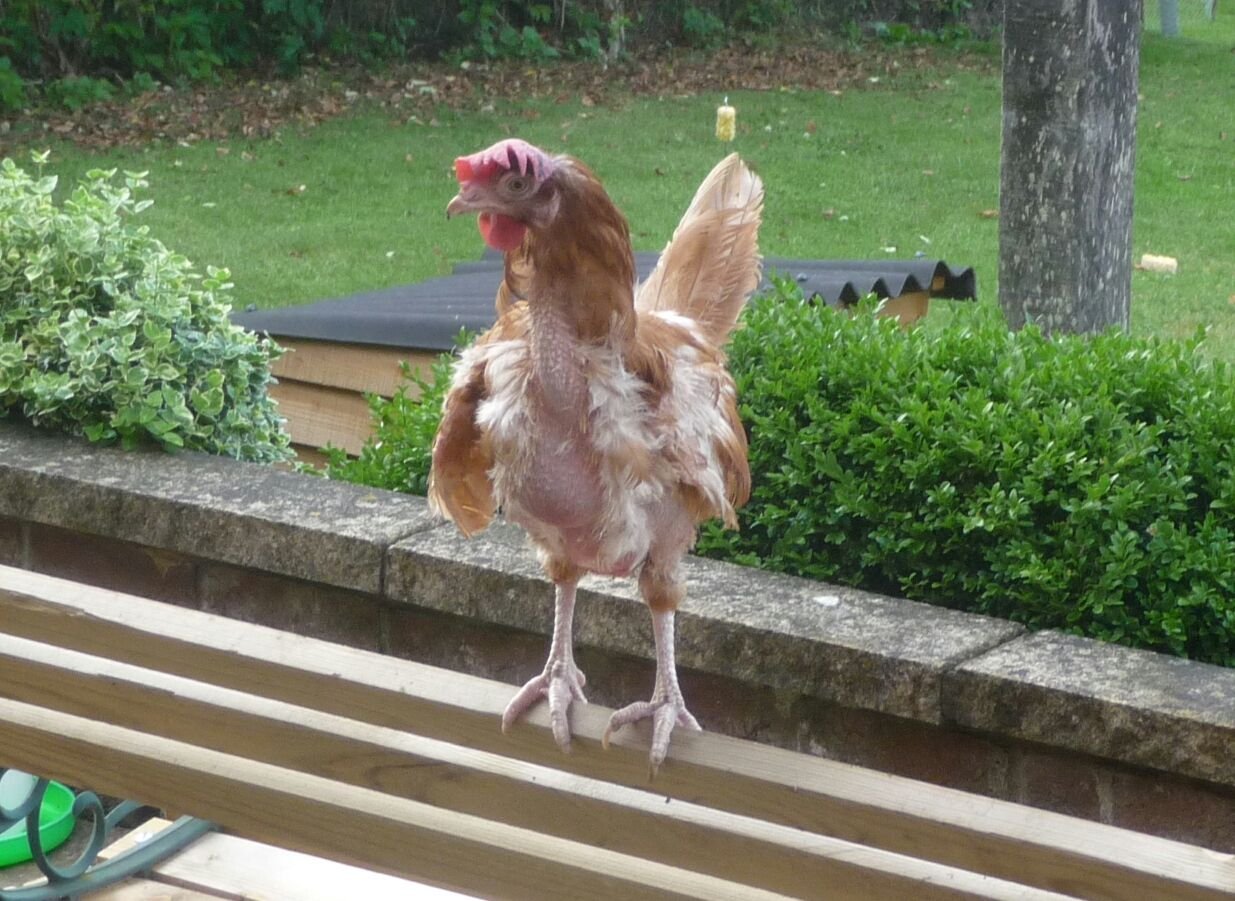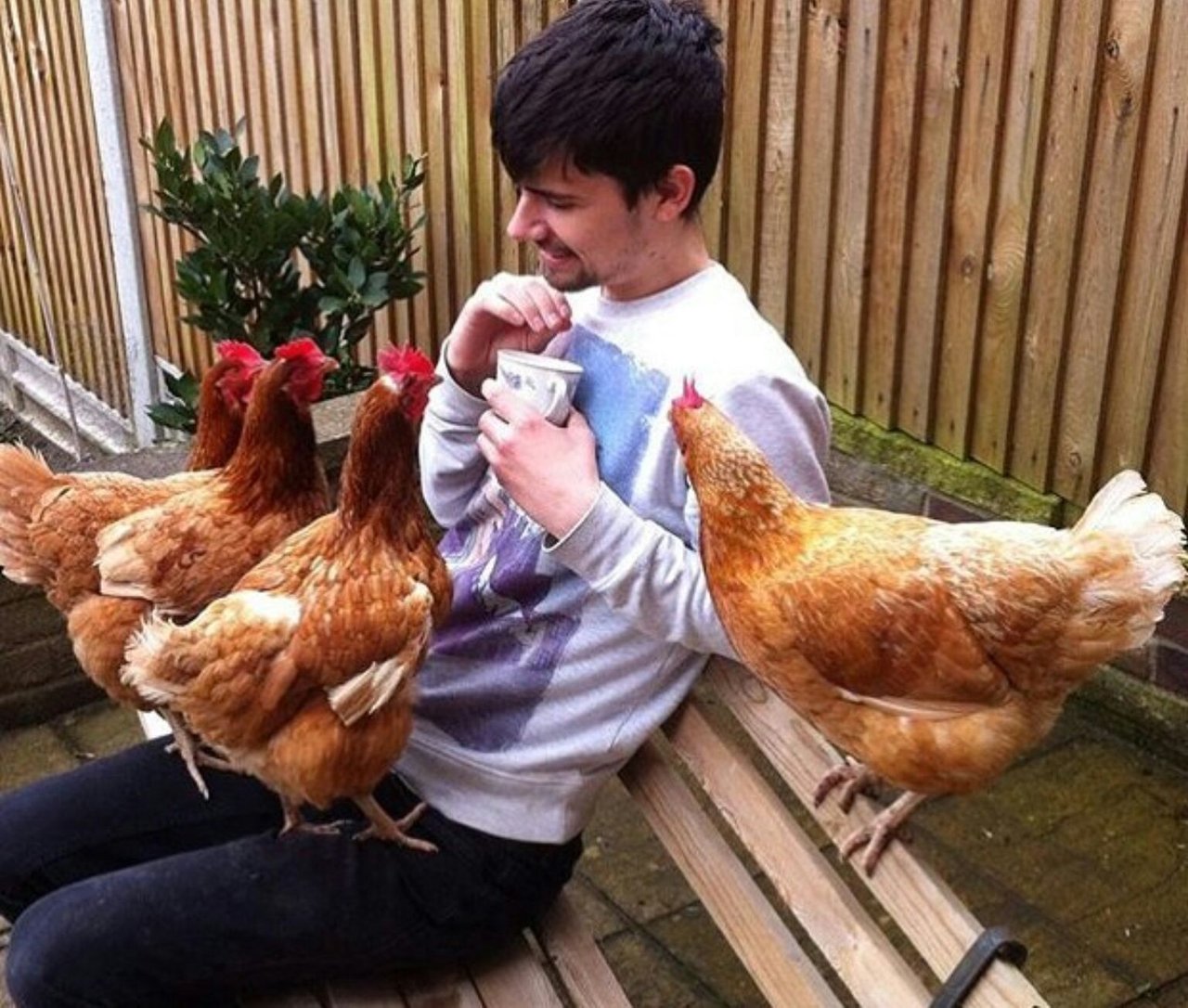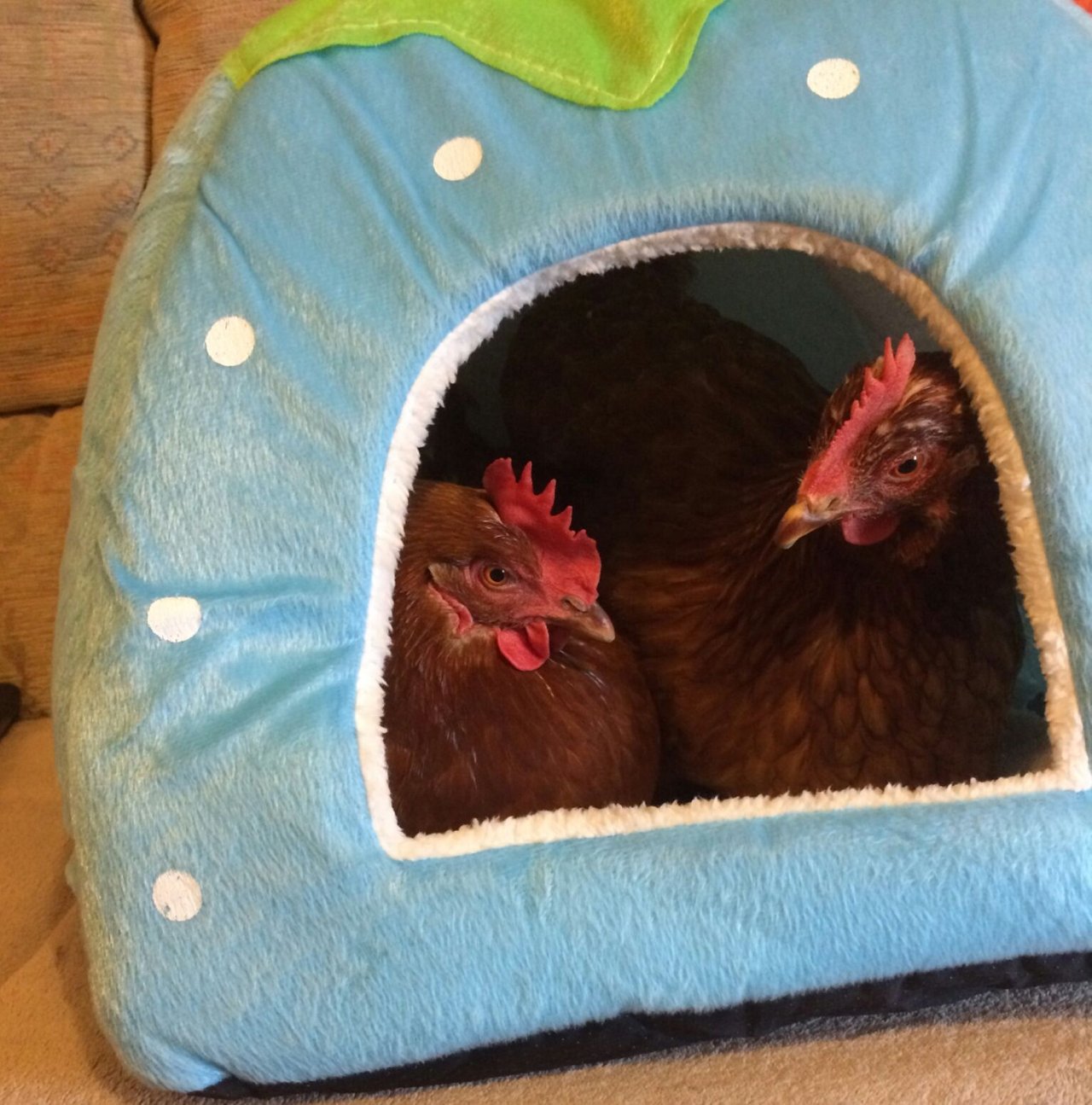My chicken keeping journey has also been a journey of discovery into how the chicken farming industry works and there is even more to it than the expected cramming of animals into small spaces.

Meet Dolly and Tulip ex battery hens. Photo courtesy of Nicky Cullum
The Egg Industry
I'll start at the beginning with egg farming. Commercial egg layers aren't a breed of hen as we know it. The are what is called a hybrid, meaning that they are a cross breed of certain breeds which hatch a bird that serves a particular purpose. In this case they hatch chicks that can be visibly sexed at hatch and the hens will lay a large egg nearly every day. It sounds pretty good until you realise the consequences of this on the chickens.
The first consequence is to the cockerel (male) hatchlings. Because hens that lay well are general a lighter bodied chicken, the males aren't deemed worth raising to adulthood for meat. So they are killed at hatch. The pullet (female) hatchlings get to grow up, but there's a catch for them as well. Once they've been laying for about a year, they are usually disposed of even if they've been raised truly free range. The reason given is because their egg quality starts to deteriorate, but the reason for the deterioration is not usually mentioned.
In a standard breed hens will lay for a season, then have a short break while they moult. When they start laying again, it's like their system has had a bit of a reset and their egg quality goes back up. Hybrid layers don't get this reset. They just keep laying eggs which takes a huge toll on their bodies and they often end up dying from complications caused by this at 2-3 years old.
There are people who rescue ex battery hens to give them a chance to live out the rest of their lives as they should have started. In the UK the British Hen Welfare Trust rescues thousands of hens when the farms have finished with them and get them rehomed. What they do is wonderful and a few lucky chickens get to experience some health and freedom while they demonstrate just how terrible the conditions they're farmed in are. However, this is just dealing with the end result of the farming practices and the next step is to stop them being farmed like this in the first place.

Rescued ex battery hen Titch on arrival at her new home. Courtesy of Nicky Cullum
I've had the pleasure of meeting on Instagram a wonderful mother and son team, Nicky and Peter, who decided to take on some ex battery hens. They have been kind enough to let me use these photos of their girls. It was Peter's idea initially to rescue these hens and see them recover as he recovered from illness himself. I thoroughly recommend visiting Nicky’s account to see these characterful girls yourself.

Dolly, Tulip, Titch and Ginger loving their new companions! This is a favourite photo of mine where they seem to gaze adoringly at Peter. They wait for him on this bench to come out with his morning tea! Sadly Tulip and Ginger have already succumbed to the tolls that high production laying put on their bodies. Photo courtesy of Nicky Cullum

Now pampered chickens Dolly and Titch enjoy their giant strawberry! Photo courtesy of Nicky Cullum
The good news is that some countries are banning caged egg farming and in Denmark, @frugallady was telling me, cage eggs are rarely sold as there is little demand for them. This is a great sign that something is working. However, barn laying chickens don't fare much better and the definition of “free range” is often abused, leading to a more recent classification of “pasture raised” to describe a truly outdoors, free range lifestyle.
The Meat Industry
As it's been decided that meat birds need to be bigger than laying birds, instead of growing out the cockerels from the egg layer production for meat they breed another hybrid. There are quite a few large chicken breeds, but they are slow growing. After all they have a lot of growing to do. So the industrial meat bird is a cross between a heavy meat breed and a fast growing breed to get the biggest bird they can as quickly as possible. These chickens are ready for slaughter in just 7-9 weeks in most cases 12 weeks for a larger roasting chicken.
From the start of their lives these chickens will eat so much that some will eat themselves to death before they reach maturity. They have a very high mortality rate. Many will also end up lame before they make maturity because their bodies can't handle the rate of growth. Some farmers will limit their food intake and allow them more free range and this does improve both the mortality rate and lameness, but I still question if this justifies a hybrid created just for meat when so many layer cockerels are being killed at hatch.
To give you an idea of the rate these chickens grow, a lady rescued a meat hybrid female and let her live out her life on her rescue farm. She actually rescued three I believe, but only one, Marshmallow, lived for any length of time, if you can count 6 months as lengthy in any way. At 5 months old she weighed a whopping 10kg (22lbs)! She struggled to walk on anything but flat ground and in the end her heart gave out. I do believe there laws to prohibit you from growing these birds past a certain age, but this doesn't address the moral implications of purposely breeding an animal knowing that this will be their quality of life.
Finding Solutions
So are there any solutions to help change these ways of farming and breeding chickens? I believe there are, but as usual I don't believe it can be done with just one solution.
Starting small I would encourage people to keep chickens or another form of poultry. Lots of people keeping them in small numbers would certainly make an impact. The only problem with this is as the chickens get older and stop laying then they may not have the room to replace them. Maybe some people could cull them for the meat, but most people would struggle to do that to a companion that has provided food for so many years. It seems only fair to return that favour with the chance to retire. This could be a way chicken rescuers who have the land can come in. I hope that one day I could do this myself. You see chickens have more use to them than laying eggs. They are also useful in orchards for helping keep weeds down and breaking the cycles of pests that affect the trees and they are a great help when it comes to preparing land for planting for the same reasons.
You could say that we have to farm in cramped conditions to be able to provide enough for our high population demands, but I believe that's just because we're doing things wrong. Herein lies the problem with monoculture farming. We don't have enough room on the land because each section is being used for just one thing. The aforementioned orchard is a prime example. Instead of having your orchard and chicken farm separate, why not put chickens in the orchard? That will reduce and maybe even eliminate the need for pesticides and herbicides. It will also reduce the need to bring in so much feed as they will get most of it from the bugs and plants in the orchard. Any feed purchased will go through the chicken digesters and be returned as a fertiliser for the trees, also reducing fertiliser costs. You've also combined the land from both chickens and orchards and could theoretically extend the orchard, growing even more trees. In this way production is expanded for the same amount of land used.
Here's another idea. The Vermont Composting Company make compost from the locals’ organic waste. They also sell eggs from chickens that are fed purely from foraging in the compost and some areas of grass on the property. The company itself is in the composting business, but the chickens they use to help with the composting process also give them another product to sell. Once again making extra uses of the space given.
So if we multipurpose the way we do things there's no reason why we can't allow the chickens to have space to roam. Hybrids aren't necessary and roosters can be the meat birds.
You can read previous posts in this series here:
#1 @minismallholding/taking-back-control-of-our-food-production-what-s-already-being-done
#2 @minismallholding/taking-back-control-of-our-food-production-sharing-the-growth
You can also find us on:
Instagram: https://www.instagram.com/minismallholding/
Facebook: https://m.facebook.com/minismallholding/
YouTube: https://m.youtube.com/channel/UCBwcsmyIkW_hIEJdLUSd44g
